
THE Amarok V6 arrived here in December 2016, but only with an eight-speed automatic gearbox and a single-range full-time 4x4 system.
At the time Volkswagen Australia said a V6 with a manual gearbox and dual-range part-time 4x4 was just 12 months away. As it has turned out the V6 manual took more than three years to arrive. And while the V6 automatic comes in everything from farm stripped to Toorak fleshed out, and with two different engine tunes (550Nm and 580Nm), the manual only comes in base spec with two same-price ($49,590 plus orc.) variants, the Core and the Core Enduro.
POWERTRAIN AND PERFORMANCE
THE Australian Amarok V6 manual is unique as it gets it own engine tune not available elsewhere in the world where the manual gearbox is mated at best to a 150kW variant of this now long-serving and widely used (inc. Porsche and Audi) VW-family 3.0-litre turbo diesel V6.
Here we get a 165kW version of the engine, complete with the over-boost function that bumps the power up to a very healthy 180kW. The overboost function comes into play between 50km/h and 120km/h but can extend to 140km/h and ramp-ups from 70 per cent throttle, and is fully available at 95 per cent throttle and beyond.
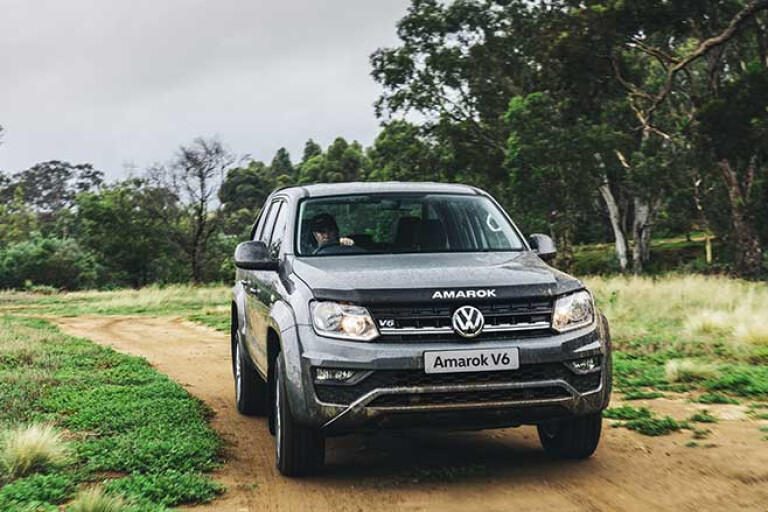
If all that sounds all a bit erratic, it’s not, as this engine delivers seamless power regardless of gear or throttle openings and offers superb in-gear flexibility where all 500Nm of torque is available from just 1250rpm and remains undiminished until 3000rpm, or 3500rpm under overboost conditions. This flat torque line gives a perfectly linear power progression throughout the normal and commonly used operating speeds of the engine.
The six-speed manual is geared to give around 60km/h/1000rpm top gear, which has the engine loping along under 1700rpm at legal highway speeds. But such is the engine’s torque at low revs that it will comfortably carry top gear on highway hills, even if relatively steep. At the same time this is also a fast ute – pedal to the metal – off the back of its 180kW, which is available when you want it most, namely overtaking speeds. All the while the engine is relatively smooth and refined although not as quiet as some of the more recent-design diesels.
For its part, the gearbox has a light action but could be a slicker and quicker in the low-gear changes. Not a deal breaker, as the engine’s flexibility means less shifting anyway, but the box isn’t as sweet as it could be.

While top is tall and relaxed, first gear is sufficiency low to provide a nicely slow, idle-speed, no-throttle crawl with good stall resistance, which means you’re not looking for low-range as soon as you head off road. What the farmers might call “a good paddock gear”.
Interestingly, while the manual’s official ADR fuel consumption is notably poorer than the automatic, on the road the manual proved to be more economical than the automatic, which we have driven and tested on numerous occasions. For easy highway driving the manual uses less than 9lt/100km while our overage test average of 10.3lt/100km is 12 to 15 per cent better than what we have typically achieved with the automatic in the past.
ON-ROAD DYNAMICS
COMPARED to the automatic V6, the manual’s on-road dynamics are the same but also very different. You get the same agile and nippy feel through the wonderfully connected steering combined with stability and poise thanks to the well-sorted front to rear suspension match. Utes shouldn’t be this good.
But with the manual you also get part-time 4x4, which means rear-drive only on the road, so a significant downgrade from the automatic’s full-time 4x4 in terms of safety, driveability and convenience under more demanding driving conditions. Wet roads and constantly changing road surfaces is where the disadvantage is most felt, but for dry-weather bitumen and easier driving conditions the playing field levels out.
OFF-ROAD
GIVEN the manual comes with dual-range gearing and the automatic is single-range only you would expect that off-road conditions would provide the manual with the knock-out blow against the automatic if this was a contest between the two. But the decision is not that clear cut.
While both the manual and the automatic Amarok V6s have driver-switched rear lockers, engaging the locker on the manual cancels the electronic traction control (ETC) on both axles. With the automatic, when the rear locker is engaged the ETC stays active on the front axle, which gives an advantage on gnarly climbs and the like, and something that we have previously found with the manual and automatic variants of the four-cylinder Amarok.
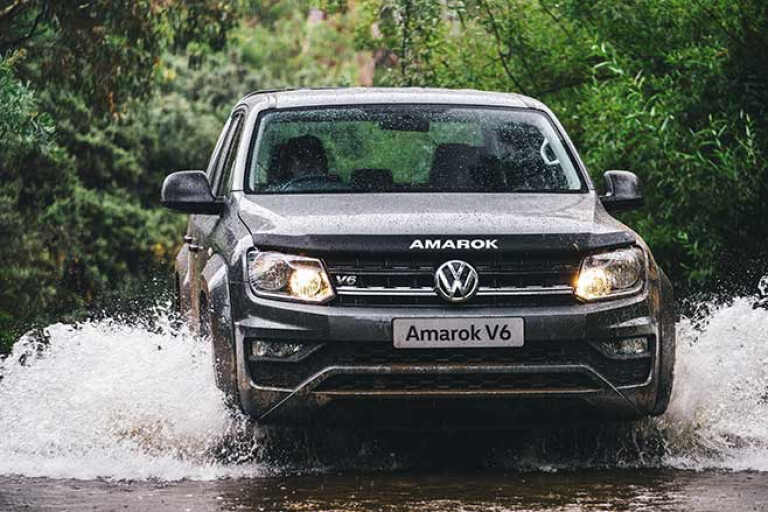
That aside, all Amaroks do well off road thanks to their generous wheel travel that puts them well ahead of most utes on the market and in the same league as the standard setting Toyota Hilux and Ford Ranger when it comes to off-road performance. With good wheel travel there’s less reliance on ETC and diff locks, it’s as simple as that.
Where the manual Amarok V6 will shine compared to the automatic V6 off road is for towing camper trailers and the like, especially in steep country, and or on sand or soft-surfaced tracks. With an excellent low-range reduction of 2.72:1, the V6 manual’s crawl ratio is also a class-leading 51:1.
Being a Core model also means the off-road practicality of 17-inch wheels, the smallest wheel that the V6 will take given the V6 gets bigger brakes than four-cylinder Amaroks and won’t take 16s. The standard-fitment light-truck all-terrain Michelins are another practical touch for straight-out-of-the-showroom off-road use.
CABIN, ACCOMMODATION AND SAFETY
THE V6 manual only comes in base ‘Core’ specification, which means rubber floors rather than carpets and the deletion of two of the 12-volt outlets in the cabin, including the handy one on the dash shelf.
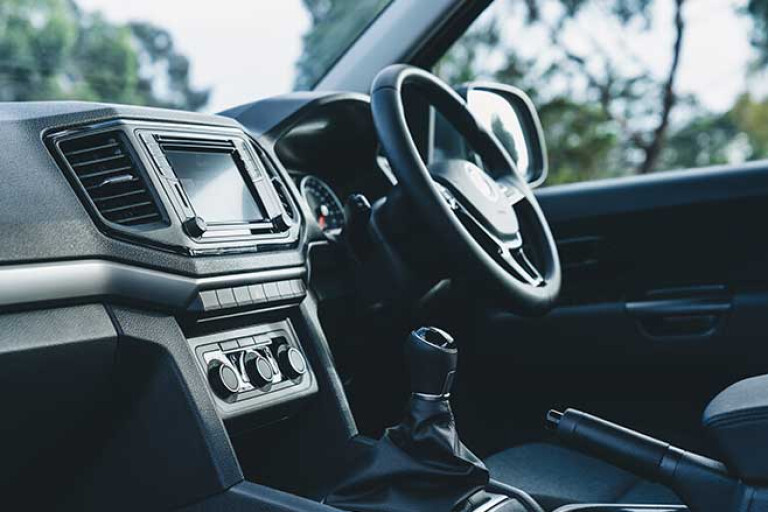
There’s no smart-key entry either, nor is there any embed sat-nav (see ‘What You Get’ sidebar) but like all Amaroks you still get a big, well-finished and nicely detailed cabin. You also get tilt-and-reach steering wheel adjustment, a welcome but still uncommon ute feature. The Amarok’s seats are also notably comfortable and the driving position excellent while the rear seat is class-leading for width even if the combined front and rear legroom isn’t as good as Ranger or Mazda’s BT-50.
The Amarok gained five-stars under the ANCAP safety system when tested years back but wouldn’t get that in 2020 given it lacks rear cabin airbags and doesn’t have any high-end safety features such as automatic emergency braking.
PRACTICALITIES
THE manual V6’s maximum tow rating is 3000kg, which is 500kg less than the automatic. This is due to a reduction in the Gross Combined Mass (GCM) from 6000kg for the automatic to 5550kg for the manual. This doesn’t affect the maximum payload rating, which remains at a tonne. As with all Amaroks you can fit a full-sized pallet between the wheel arches, a distinct advantage over all of the popular utes in this class. The location of the tub’s tie-downs on the load-bed floor is another Amarok ‘smart’ most other utes don’t get. The manual also gets a standard steel tub (no plastic) although a multi-piece plastic tub liner is offered as a factory accessory.
WHAT YOU GET
CORE specification may be entry-level but is sufficiently well-equipped to cover the basics. The safety kits runs to driver and passenger front and front-side airbags, ISOFIX child seat tethers and all of the usual electronic chassis controls including trailer-sway control. Like all Amaroks it gets tilt-and-reach steering wheel adjustment, cruise control, Apple CarPlay and Android Auto, voice-control phone function, rear parking sensors, a reversing camera, front and rear fogs, and a rear diff lock.
Unique Core specification includes single-zone air-con, a 6.33-inch touchscreen, a six-speaker audio system with CD, Aux, USB and SD inputs, cloth seats, rubber floor coverings, and a protection plate under the engine. The Core Enduro variant, as tested here, adds $1200 worth of extras in a black sportsbar, bonnet protector, and graphics, all for no extra cost.
FINAL SAY
THE Amarok V6 manual might well be a last milestone in this generation Amarok’s evolution in Australia. The Amarok is ten years old now (nine in Australia) and is the oldest of the current mainstream utes in terms of its generational positioning and is up for replacement. What’s kept it ‘new’ is, of course, the V6 engine, which only appeared here in late 2016.
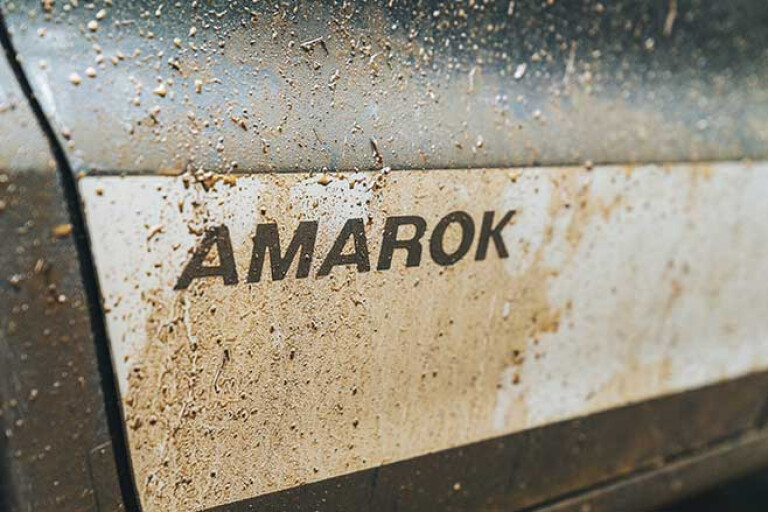
Given the next generation Amarok looks to be a design shared with Ford, and more Ford than VW, will this make this generation Amarok unique and perhaps the best ever? As good as the current Ranger is, it still lags behind the Amarok in many ways.
So has the manual Amarok been worth the wait? Well if you’re towing in difficult off-road conditions, most certainly it has been. If you like the control and driving pleasure that only a manual can bring, then most certainly again. But given the automatic doesn’t want for off-road ability even without low range, and brings the safety, convenience and ease-of-driving of full-time 4x4 complete with a self-locking centre diff, it’s still arguably the better all-rounder.
If God designed the Amarok it would have a full-time dual-range 4x4 system available with both automatic and manual gearboxes. But given VW designed the Amarok and its engineers have been no doubt shackled by the bean counters you’re limited to an automatic with a full-time single-range 4x4 system or a manual with a part-time dual-range 4x4 system. Take your choice.
AMAROK V6 CORE MANUAL: SPECS
Engine: 3.0L V6 turbo diesel
Power/Torque: 165kW/500Nm
Gearbox: Six-speed manual
4x4 System: Dual-range part-time
Crawl Ratio: N/A
Kerb Weight: 2076kg
GVM: 3080kg
Payload: 1004kg
Towing Capacity: 3000kg
GCM: 5550kg
Fuel Tank Capacity: 90 litres
ADR Fuel Claim: 9.7L/100km
Approach Angle: 28⁰
Ramp-over Angle: 23⁰
Departure Angle: 23.6⁰
Wading Depth: 500mm
Ground Clearance: 192mm
PRICE
$49,590
SECOND OPINION: LAUNCH REVIEW
Tristan Tancredi - 21/02/20
Volkswagen Australia has taken a gamble releasing a niche six-speed manual variant of its V6-powered Volkswagen Amarok ute.
Granted, the V6 variant makes up almost 90 per cent of all private Amarok sales in Australia, which isn’t surprising when you consider it makes around 100 more Newton metres than its four-cylinder stablemate, and you don’t have to swipe the credit card for that much more coin. In fact, owners can now get all of the benefits of six cylinders and have change from $50K. So, offering a manual variant is a gamble well worth taking, we reckon.

The stick-shift entry into the market means this Amarok is the only V6-powered manual dual-cab on sale in Australia – very niche, you could say. Volkswagen has already sold 60 V6 manual variants, and demand for more is on a pure wait-and-see basis, with VW officials biding their time to see how many units shift in initial months.
The six-speed manual gearbox in question is the same gearbox used in the Amarok four-cylinder variants, but the shifts have been recalibrated and materials strengthened due to the increased torque running through it. The shifts are clean and there’s plenty of power from the V6 engine on tap early, which helps when overtaking slow caravanners on freeway entry ramps. Planting the throttle to the rubber footwell provides ample urge without much fuss; the engine is smooth and quiet for a diesel.
The V6 is the 3.0-litre turbo-diesel unit with 165kW (180kW on overboost) and 500Nm – 50Nm less than the auto V6 variants but 80Nm and 100Nm more than the four-cylinder models. Engineers spent some time strengthening aspects of the V6 variants to cater for the hike in torque, including adding bars in front of the radiator for added protection, and strengthening the front diff housing.
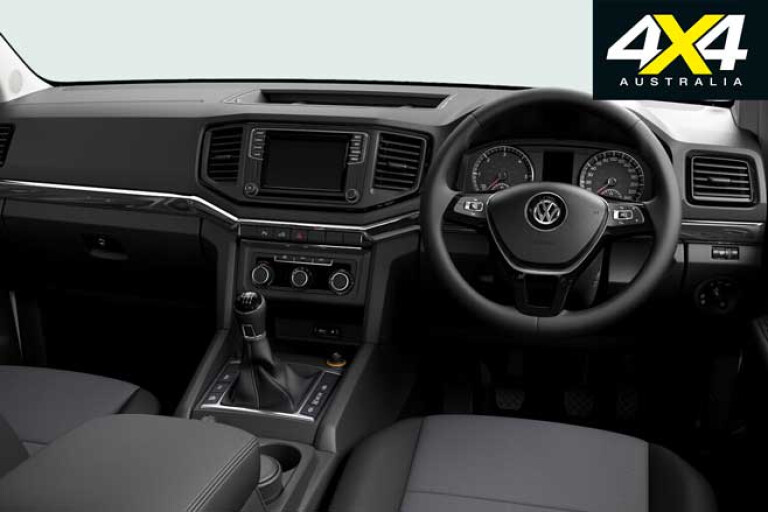
It’s on the highway when you have to remind yourself that you’re driving a dual-cab ute. Yes, really. The combination of the smooth, punchy engine and the slick-shifting six-speed manual, as well as the uniquely located leaf springs at the rear – positioned beside the chassis rails rather than beneath them, and in-line with the rear diff – sure-up balance, ensuring the Amarok remains passenger-car-like on freeway runs.
Off-road, though, is where the manual Amarok V6 reaps the biggest benefit, with VW pairing the six-speed manual with a traditional part-time 4WD system with a two-speed transfer case (high and low range); in lieu of the auto’s permanent single-range 4WD system. Now with a locked 50/50 torque split and low range, the manual V6 Amarok should appease 4x4 purists who questioned the auto’s full-time set-up.
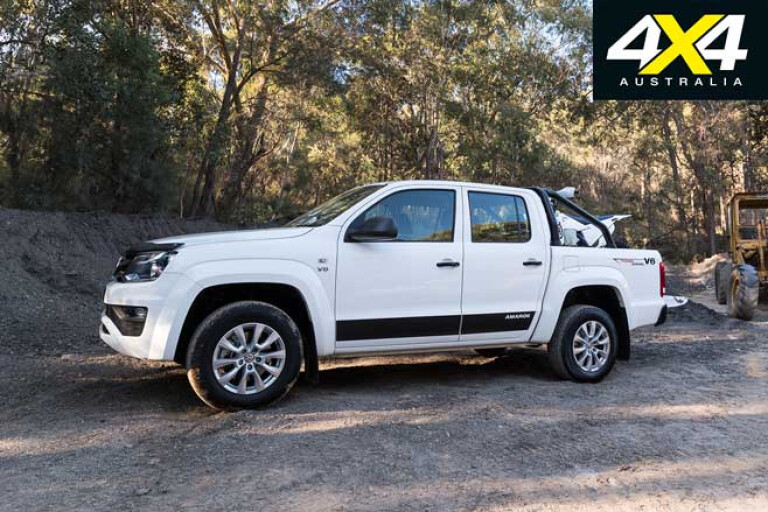
In addition, the manual V6 Amarok is equipped with a mechanical diff lock for extreme low-speed off-roading – ABS/ESP deactivates once the diff lock is engaged – as well as an Off-Road Mode which activates electrical interventions including Electronic Stability Program (ESP) and hill-descent assist (with a control range between 2km/h and 30km/h).
For troglodytes who believe electronic aids are for wimps, there’s the option to go old-school low-low without technological intervention. However, you’re not entirely on your own, with electronic brake support remaining in play to ensure you don’t end up belly-up.
With the 4WD systems activated, via simple-to-use buttons either side of the gear stick on the centre console, the manual Amarok V6 proved it’s just as capable on the dirt as it is on bitumen. With grip often akin to an ice-rink on the test route at the Melbourne 4x4 training and proving ground in Werribee, the Amarok – on all-terrain rubber, mind you – excelled on the slippery slopes.

These slightly aggressive all-terrains (deflated to 22psi) are stock ’Rok equipment, meaning they’ll be slapped beneath Amaroks leaving showrooms, and they provide a fine balance between on- and off-road performance.
Despite tricky inclines saturated from constant rain and torn up by the recon rigs, the Amarok remained well-planted and composed, with adequate approach (23°) and departure (23.6°) angles and plenty of wheel travel. However, V6 ’Roks have a wading depth of just 500mm, so a snorkel would be a great addition.
Readers of this magazine know the Amarok V6 auto is a very comprehensive vehicle, in the upper echelon in terms of premium dual-cab offerings despite its ageing platform, and that won’t change until the Ford-Volkswagen partnership swings into full motion for the next-gen in a few years’ time.

Even in base Core spec the current Amarok is well equipped, with a well-appointed cabin that’s simple yet effective in its layout. It gets cloth seating, a leather-wrapped steering wheel, heavy duty front and rear rubber floors (extremely useful on our test day) and a touchscreen with modern apps including Apple CarPlay/Android Auto. The touchscreen can be controlled via buttons and dials, of great benefit when off-road.
The three-pedal cog-swapper has a load capacity of 1004kg and less towing capacity than the V6 auto – 3000kg versus 3500kg. On the safety front it may still lack rear and side curtains, as well as autonomous emergency braking, but it’s encouraging that brands are listening to what fans want. While it might be very niche, it’s nice to know that there are brands like Volkswagen that are still willing to bring to market something for the traditionalists.
The Amarok V6 Core 4x4 manual and V6 Core Enduro 4x4 both have an RRP of $49,590, the latter adding black ‘Enduro’ side decals, a front bonnet protector and black sports bar.

COMMENTS